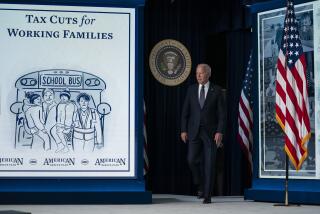YOUR TAXES : PART THREE: INVESTING, SAVING, SPENDING : Little-known IRS rule gives working parents a break on child care
- Share via
Thanks to a little-known tax loophole, working parents may be able to call on their old, though seldom doting, Uncle Sam for help in footing a substantial amount of their child-care expenses.
Until recently, the only provision of the tax code that helped working parents to pay for child care has been the standard tax credit that tops out at $720 for a single dependent in a low-income family.
Given the high cost of child care, that benefit is not much help. Care in the home costs more than $200 per week, and even day-care centers cost more than $100 per week.
But a little-known provision, called Section 125 of the tax code, offers substantially superior benefits. Under the IRS rules that govern so-called cafeteria benefits, an employer can set up an escrow account for an employee that allows up to $5,000 of gross income to be diverted tax-free.
For a taxpayer at the maximum 38.5% bracket in 1987, the Section 125 plan would be worth $1,925. Unlike the standard child-care tax credit, the Section 125 plan provides greater benefits for those in the highest tax bracket.
So far, very few employers offer the Section 125 benefits, according to Pamela Pecarich, a partner at the accounting firm of Coopers & Lybrand.
Under Section 125, dependent-care services for children under age 15 and other dependents who are physically or mentally unable to care for themselves may be paid out of the escrow account. That care may include the expenses for a housekeeper, baby-sitting services inside your home or elsewhere and schooling costs for children not yet in the first grade.
Section 125 plans set up by employers typically require an employee to submit a “request for reimbursement form,” as often as once each week, to make withdrawals from the escrow account. Of course, you must have an equal amount deducted from your gross pay.
The $5,000 per year would amount to $96.15 weekly. That could pay anywhere from half to all of the care expenses for a single child. To learn more about it, contact your employer’s benefits office and see if they offer the Section 125 plan.
The only cost to the employer is the administrative cost of setting up the plan, so there is little reason for any employer not to offer the plan.
More to Read
Inside the business of entertainment
The Wide Shot brings you news, analysis and insights on everything from streaming wars to production — and what it all means for the future.
You may occasionally receive promotional content from the Los Angeles Times.











